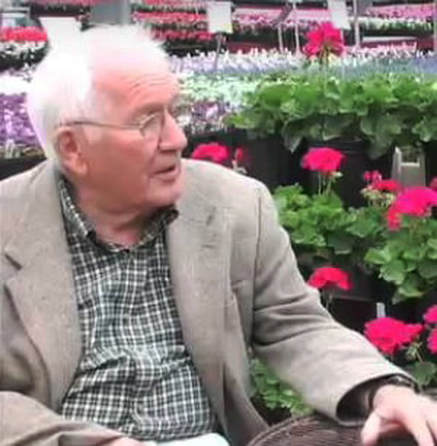Siebenthaler Family—Cultivating Success Through Six Generations
“Man probably isn’t going to be the last critter on this earth.”
—Bob Siebenthaler
|
Beautifying Dayton since 1870, the Siebenthalers continue to succeed by adapting to a changing market, by innovative tree patents, and by involvement in their industry and community groups like MetroParks and the Beaver Creek Wetlands Association. Bob Siebenthaler is a member of the Engineers Club of Dayton.
Noting that Dayton is a “City of Innovators”, Bob Siebenthaler met Orville Wright, Charles Kettering, and Edward Deeds. Siebenthaler concludes that innovation is thriving today in the Dayton region.
Video courtesy of DaytonBusinessSpotlight.com
Video courtesy of DaytonBusinessSpotlight.com
Cultivating Success Across Six Generations
By Mark Martel
Companies have life spans, just as do people or plants. Today, only half of small businesses survive for at least four years. By year forty, let alone by year 140, only a tiny few remain in operation. The Siebenthaler Company is one of the rarities. Begun around 1870 it is now one of the nation’s oldest plant nurseries, in its sixth generation of family ownership in Dayton, Ohio.
Siebenthaler family members continually adapted their business as customers shifted from farmers to homeowners to larger organizations. While growing the horticulture business, they also found time to contribute their unique skills to community groups like MetroParks, and to make major gifts to conservation groups like the Beaver Creek Wetlands. What are the secrets to such continued vigor? Let’s begin with the family tree.
In 1831, the Swiss-German Siebenthaler family set out for America and settled in Cincinnati. A cholera epidemic drove them to nearby St. Peter, Indiana by 1834. There in a tiny house heated by cattle living on the floor below, son George learned to raise hops for brewers, though he had never been a farmer. George and brother Phillip often walked the 40 miles back to Cincinnati, earning the considerable sum of five dollars to play fiddle and clarinet (about $120 in today’s dollars).
In 1867 George moved to Dayton near today’s Siebenthaler Avenue and Catalpa Drive. There he built a farm, from which son John founded a nursery business in 1870 (1872 according to some records), selling fruit trees, berry plants, and grape vines at a local market at first.
The Dayton farm grew from eight to eighty acres, as the nursery began to cultivate roses and enter the landscaping arena. The city grew like Topsy alongside, from 30,000 souls in 1870 to 60,000 in 1890, doubling again by 1910 and yet again by midcentury.
By 1920 the newly incorporated Siebenthaler Company’s fruit tree sales had been largely replaced by ornamental shrubs and trees that were produced and shipped to all parts of the country. 140 acres were bought south of town in what would become the city of Moraine. At least four of John’s children brought different talents to operations as the third generation of Siebenthalers. Son Clarence grew the landscaping service, son John D. developed new plants and son Wilber ran operations with sister Mary Siebenthaler Wilson. The world began to take notice.
A 1929 Dayton newspaper wrote: “There is no need for any person to visit the Washington Botanical Gardens, for right here in Dayton, at the Siebenthaler Nursery, the study of indigenous ornamental shrubbery is complete.” ‘
The company was able to prosper during the Depression. John D. developed over 30 varieties or oriental poppies which proved popular, as well as lilacs and shade trees. The landscaping division also grew, over time beautifying major Dayton locations such as NCR, the Dayton Art Institute, Dayton Public Library and major residences like those of Orville Wright and inventor Charles Kettering.
As the family and business grew, both branched out to additional properties in Moraine and Beavercreek. The growth would sow the seeds of later conflict as more descendants tried to share the business.
John’s nephew Robert, or Bob as he likes to be called, recalls that “As a young person I had an opportunity to meet Orville Wright. As a matter of fact, one day my father Clarence dropped me off at his office for, oh, an hour. And he enthralled me with all the little toys he liked to make.” Bob met other prominent Dayton innovators like Colonel Deeds and Charles Kettering as well. Orville and Wilbur Wright’s sister Katharine was in the Siebenthaler wedding.
The famous Californian Luther Burbank, responsible for 800 plant varieties, had helped inspire the Plant Patent Act of 1930. The act offered a plant’s “inventor” exclusive rights to their work for 20 years—at least theoretically; plants were easy to copy. The developer of the first tree patented in 1935, the Hass Avocado, lost heavily. “Growers would buy one tree…then re-graft their whole grove with the bud wood from that one tree.” Siebenthaler’s sought ways to profitably succeed in this new field.
Clarence and son Bob spotted some distinctive Honey Locust trees while driving up to Bob’s college. One lacked the usual thick masses of thorns along the trunk. It proved seedless, but the nursery figured out how to propagate genetically identical trees through budding.
The Siebenthaler Comapny applied in 1947 for its first patent for the “Moraine” Honey Locust. They received the low patent number 836, and claim it as the first shade tree ever patented. The locust was a great success—the small leaves and lack of seed pods minimized raking in fall, and being seedless meant more sales, which eventually peaked at 75,000. The tree was described as a radical innovation and a replacement for the American elm, which was dying off from Dutch elm disease. Today mature Moraine Locusts line many major streets in Dayton and surrounding communities. The royalties helped support Bob’s college tuition.
Bob went off to study Landscape Architecture at Michigan State through the Horticulture Department. He quickly met a girl named Joan he would later marry. But while Bob was still a freshman his father Clarence died.
The college swelled from 8,000 to 45,000 students by his graduation, as WWII ended and vets enrolled on the G.I. bill. Soon those vets would be buying houses and planting yards.
But before Bob put down his own roots he served in the Korean War. There he ran a motorized heavy mortar outfit as company commander to over 300 men. Bob quickly gained experience the hard way in management and logistics.
After, he joined the family business in Dayton, which he had assumed would be run by his uncles. Instead, the company’s branching ownership was pruned back, and Bob ended up in charge.
Running a family business long-term can be like developing a new plant variety. Later generations must retains the original’s unique traits, yet vary enough to stay robust in a continually changing environment.
Bob jokes he kept the business alive past the typical third generation slump. He took the company into retailing, increased the landscaping business and continued his father’s work developing new trees before getting into community service and philanthropy.
Three later tree patents were granted in John D. Siebenthaler’s name: the Moraine Ash tree in 1958, Moraine Sweet Gum in 1980 and Wright Brothers Sugar Maple in 1981. One maple stands behind the Wright Cycle Company building in West Dayton. The original tree was spotted in a woodlot along Springboro Pike south of Dayton, sporting exceptional fall coloring and shape. A large example of the maple was donated to Carillon Park for the Dayton bicentennial, and had to be flown in by helicopter.
An early company slogan was “Let’s make Dayton the city beautiful.” It seems to have worked. Bob accepted two beautification awards at White House ceremonies in the 1960s and 1970s.
Siebenthaler landscaped high profile sites such as the NCR Country Club, careful to avoid a monoculture of identical plantings so as to minimize threats like Dutch elm disease. “You never know what will get you,” Bob says, explaining the prudence of genetic diversity. In the 1950s retail operations began, and the firm built its second garden center in 1958. Suburbia provided a changing market for Siebenthaler’s landscaping services. By the company’s centennial it had expanded in Beavercreek to 432 acres. “20 acres short of a square plot,” as Bob describes it.
As the region grew, new concerns arose for the preservation of natural areas and recreational parks. The late Marie Aull of Aullwood encouraged Bob to get involved in the county-wide MetroParks organization.
MetroParks served the whole Dayton region, and has grown to include urban parks, extensive nature reserves and former farms like Aullwood and Carriage Hill. The Englewood and Germantown reserves alone constitute close to 20 square miles. Bob served for 21 years as one of three MetroParks commissioners, and was instrumental in the site selection of Weygerzen Gardens. He feels the Park District was very efficient. “Either decisions were unanimous or it didn’t happen.”
Bob and his wife Joan stayed interested in the business “by finding something different to do,” serving on professional boards. As he reached retirement age he stayed active by giving back to the community through the Dayton Rotary, the ISUS (Improved Solutions for Urban Systems) the Youth Board, Salvation Army Board and the Board of Shiloh Cemetery.
Bob is perhaps proudest of the firm’s 1995 contribution of Siebenthaler Fen to the Beaver Creek Wetlands, a mixed purchase and gift from the firm’s Beavercreek operation. “I made them buy it to make sure they would take care of it.” The firm funded an observation tower that overlooks Siebenthaler Fen, 130 acres where native species are rebounding.
“Who would have thought there were still beaver?” notes Bob. “It proves that man probably isn’t going to be the last critter on this earth.”
The firm remains vibrant, with $6 million in annual revenues, two garden centers, two nurseries in Beavercreek and Centerville, and some land in Moraine. The main offices in Dayton house their landscaping services. A full-time staff of 60 includes many professionals in landscape design, construction and customer service.
Bob’s children, Jeff and Laurie now manage the company as president and retail manager respectively. Grandsons Robert, and Colin are now working full-time as the family business' sixth generation.
The Siebenthaler Company played an important part in the development of the US nursery business.
Bob is optimistic about the region’s future. He was quoted in a Dayton Business Spotlight video: “There are people inventing things here in Dayton that I think will have those sorts of effects many years down the line…From the innovation standpoint I think it is almost just starting. Between Wright-Patterson Air Force Base and the University of Dayton, Research Park and other private things that are going on, I don’t see it slowing down.”
Companies have life spans, just as do people or plants. Today, only half of small businesses survive for at least four years. By year forty, let alone by year 140, only a tiny few remain in operation. The Siebenthaler Company is one of the rarities. Begun around 1870 it is now one of the nation’s oldest plant nurseries, in its sixth generation of family ownership in Dayton, Ohio.
Siebenthaler family members continually adapted their business as customers shifted from farmers to homeowners to larger organizations. While growing the horticulture business, they also found time to contribute their unique skills to community groups like MetroParks, and to make major gifts to conservation groups like the Beaver Creek Wetlands. What are the secrets to such continued vigor? Let’s begin with the family tree.
In 1831, the Swiss-German Siebenthaler family set out for America and settled in Cincinnati. A cholera epidemic drove them to nearby St. Peter, Indiana by 1834. There in a tiny house heated by cattle living on the floor below, son George learned to raise hops for brewers, though he had never been a farmer. George and brother Phillip often walked the 40 miles back to Cincinnati, earning the considerable sum of five dollars to play fiddle and clarinet (about $120 in today’s dollars).
In 1867 George moved to Dayton near today’s Siebenthaler Avenue and Catalpa Drive. There he built a farm, from which son John founded a nursery business in 1870 (1872 according to some records), selling fruit trees, berry plants, and grape vines at a local market at first.
The Dayton farm grew from eight to eighty acres, as the nursery began to cultivate roses and enter the landscaping arena. The city grew like Topsy alongside, from 30,000 souls in 1870 to 60,000 in 1890, doubling again by 1910 and yet again by midcentury.
By 1920 the newly incorporated Siebenthaler Company’s fruit tree sales had been largely replaced by ornamental shrubs and trees that were produced and shipped to all parts of the country. 140 acres were bought south of town in what would become the city of Moraine. At least four of John’s children brought different talents to operations as the third generation of Siebenthalers. Son Clarence grew the landscaping service, son John D. developed new plants and son Wilber ran operations with sister Mary Siebenthaler Wilson. The world began to take notice.
A 1929 Dayton newspaper wrote: “There is no need for any person to visit the Washington Botanical Gardens, for right here in Dayton, at the Siebenthaler Nursery, the study of indigenous ornamental shrubbery is complete.” ‘
The company was able to prosper during the Depression. John D. developed over 30 varieties or oriental poppies which proved popular, as well as lilacs and shade trees. The landscaping division also grew, over time beautifying major Dayton locations such as NCR, the Dayton Art Institute, Dayton Public Library and major residences like those of Orville Wright and inventor Charles Kettering.
As the family and business grew, both branched out to additional properties in Moraine and Beavercreek. The growth would sow the seeds of later conflict as more descendants tried to share the business.
John’s nephew Robert, or Bob as he likes to be called, recalls that “As a young person I had an opportunity to meet Orville Wright. As a matter of fact, one day my father Clarence dropped me off at his office for, oh, an hour. And he enthralled me with all the little toys he liked to make.” Bob met other prominent Dayton innovators like Colonel Deeds and Charles Kettering as well. Orville and Wilbur Wright’s sister Katharine was in the Siebenthaler wedding.
The famous Californian Luther Burbank, responsible for 800 plant varieties, had helped inspire the Plant Patent Act of 1930. The act offered a plant’s “inventor” exclusive rights to their work for 20 years—at least theoretically; plants were easy to copy. The developer of the first tree patented in 1935, the Hass Avocado, lost heavily. “Growers would buy one tree…then re-graft their whole grove with the bud wood from that one tree.” Siebenthaler’s sought ways to profitably succeed in this new field.
Clarence and son Bob spotted some distinctive Honey Locust trees while driving up to Bob’s college. One lacked the usual thick masses of thorns along the trunk. It proved seedless, but the nursery figured out how to propagate genetically identical trees through budding.
The Siebenthaler Comapny applied in 1947 for its first patent for the “Moraine” Honey Locust. They received the low patent number 836, and claim it as the first shade tree ever patented. The locust was a great success—the small leaves and lack of seed pods minimized raking in fall, and being seedless meant more sales, which eventually peaked at 75,000. The tree was described as a radical innovation and a replacement for the American elm, which was dying off from Dutch elm disease. Today mature Moraine Locusts line many major streets in Dayton and surrounding communities. The royalties helped support Bob’s college tuition.
Bob went off to study Landscape Architecture at Michigan State through the Horticulture Department. He quickly met a girl named Joan he would later marry. But while Bob was still a freshman his father Clarence died.
The college swelled from 8,000 to 45,000 students by his graduation, as WWII ended and vets enrolled on the G.I. bill. Soon those vets would be buying houses and planting yards.
But before Bob put down his own roots he served in the Korean War. There he ran a motorized heavy mortar outfit as company commander to over 300 men. Bob quickly gained experience the hard way in management and logistics.
After, he joined the family business in Dayton, which he had assumed would be run by his uncles. Instead, the company’s branching ownership was pruned back, and Bob ended up in charge.
Running a family business long-term can be like developing a new plant variety. Later generations must retains the original’s unique traits, yet vary enough to stay robust in a continually changing environment.
Bob jokes he kept the business alive past the typical third generation slump. He took the company into retailing, increased the landscaping business and continued his father’s work developing new trees before getting into community service and philanthropy.
Three later tree patents were granted in John D. Siebenthaler’s name: the Moraine Ash tree in 1958, Moraine Sweet Gum in 1980 and Wright Brothers Sugar Maple in 1981. One maple stands behind the Wright Cycle Company building in West Dayton. The original tree was spotted in a woodlot along Springboro Pike south of Dayton, sporting exceptional fall coloring and shape. A large example of the maple was donated to Carillon Park for the Dayton bicentennial, and had to be flown in by helicopter.
An early company slogan was “Let’s make Dayton the city beautiful.” It seems to have worked. Bob accepted two beautification awards at White House ceremonies in the 1960s and 1970s.
Siebenthaler landscaped high profile sites such as the NCR Country Club, careful to avoid a monoculture of identical plantings so as to minimize threats like Dutch elm disease. “You never know what will get you,” Bob says, explaining the prudence of genetic diversity. In the 1950s retail operations began, and the firm built its second garden center in 1958. Suburbia provided a changing market for Siebenthaler’s landscaping services. By the company’s centennial it had expanded in Beavercreek to 432 acres. “20 acres short of a square plot,” as Bob describes it.
As the region grew, new concerns arose for the preservation of natural areas and recreational parks. The late Marie Aull of Aullwood encouraged Bob to get involved in the county-wide MetroParks organization.
MetroParks served the whole Dayton region, and has grown to include urban parks, extensive nature reserves and former farms like Aullwood and Carriage Hill. The Englewood and Germantown reserves alone constitute close to 20 square miles. Bob served for 21 years as one of three MetroParks commissioners, and was instrumental in the site selection of Weygerzen Gardens. He feels the Park District was very efficient. “Either decisions were unanimous or it didn’t happen.”
Bob and his wife Joan stayed interested in the business “by finding something different to do,” serving on professional boards. As he reached retirement age he stayed active by giving back to the community through the Dayton Rotary, the ISUS (Improved Solutions for Urban Systems) the Youth Board, Salvation Army Board and the Board of Shiloh Cemetery.
Bob is perhaps proudest of the firm’s 1995 contribution of Siebenthaler Fen to the Beaver Creek Wetlands, a mixed purchase and gift from the firm’s Beavercreek operation. “I made them buy it to make sure they would take care of it.” The firm funded an observation tower that overlooks Siebenthaler Fen, 130 acres where native species are rebounding.
“Who would have thought there were still beaver?” notes Bob. “It proves that man probably isn’t going to be the last critter on this earth.”
The firm remains vibrant, with $6 million in annual revenues, two garden centers, two nurseries in Beavercreek and Centerville, and some land in Moraine. The main offices in Dayton house their landscaping services. A full-time staff of 60 includes many professionals in landscape design, construction and customer service.
Bob’s children, Jeff and Laurie now manage the company as president and retail manager respectively. Grandsons Robert, and Colin are now working full-time as the family business' sixth generation.
The Siebenthaler Company played an important part in the development of the US nursery business.
Bob is optimistic about the region’s future. He was quoted in a Dayton Business Spotlight video: “There are people inventing things here in Dayton that I think will have those sorts of effects many years down the line…From the innovation standpoint I think it is almost just starting. Between Wright-Patterson Air Force Base and the University of Dayton, Research Park and other private things that are going on, I don’t see it slowing down.”
John D. Siebenthaler Tree Patents
Moraine Locust (PDF) 1947
Moraine Ash (PDF) 1958
Wright Brothers Sugar Maple (PDF) 1978
Sweet Gum (PDF) 1978
Moraine Ash (PDF) 1958
Wright Brothers Sugar Maple (PDF) 1978
Sweet Gum (PDF) 1978
Related
Siebenthaler Family Record - 1831-1741 by Ira Alfred Siebenthaler (PDF)
Siebenthaler Family Archives at Wright State University Library Special Collections and Archives
The Siebenthaler Company
Five Rivers Metroparks History
Beaver Creek Wetlands Association
US Plant Patent Act of 1930
Wikipedia entry on “Cultivar”
Hass Avocado History - First tree patent ever issued
Siebenthaler Secrets to Longevity and Innovation
Dayton Innovation Legacy is a multimedia website and educational resource about Engineers Club of Dayton members who represent a living history of innovation for over 100 years. Dayton Innovation Legacy was made possible in part by the Ohio Humanities Council, a State affiliate of the National Endowment for the Humanities. |




